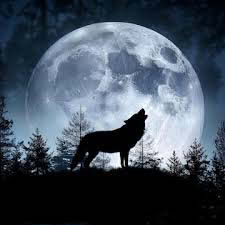 Explore the spiritual meaning of January’s full Wolf Moon as we navigate cold, long nights and gloomy days.
Explore the spiritual meaning of January’s full Wolf Moon as we navigate cold, long nights and gloomy days.
In many traditional cultures, each month had (and still has) a full moon with a symbolic name. These names generally align with seasonal happenings and what people once needed to do for survival during that particular time of year. The name for January’s lunation is the Wolf Moon, according to Wiccan, English Medieval, and many Native American traditions. The Wolf Moon refers to the wolves that would howl in the long dark nights during this time of the year. The Cree people refer to it as the Cold Moon, and for the Dakota it is the Severe Moon.
What the Full Wolf Moon Represents
As all these names indicate, there is something cold, hard, and a little scary about January’s full moon time. From the perspective of people who lived off the land, this would have been the time when food stores from the harvest were running out, and the abundance of the spring was still very far away. It would have been easy to go hungry during this time.
Though many of us in the present day live in urban environments where food is plentiful, there is still something severe about January. The holidays are over, and we’re in a bit of a spiritual hangover. The fun and connection that took place throughout December is now over; alternatively, if the holidays were stressful for you, you may still be in recovery mode in January. The nights are still long, dark, and cold, and the promise of spring feels so far away. This can be a dark time, literally and figuratively.
Our vital energy is very low in January. We have moved past the energetic nadir of the winter solstice, which means the light of the sun is beginning to wax again, but just barely. If we set New Year’s resolutions, they do best in the realm of dreams and intentions right now—new things are much easier to start in the spring, especially when our intentions involve changing ingrained habits that give us comfort and a sense of safety. It’s easy to get depressed in January—classically, the third Monday in January is known as Blue Monday, the most depressing day of the year.
— © Spirituality & Health, 2024, by Julie Peters